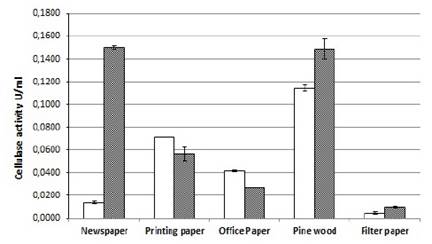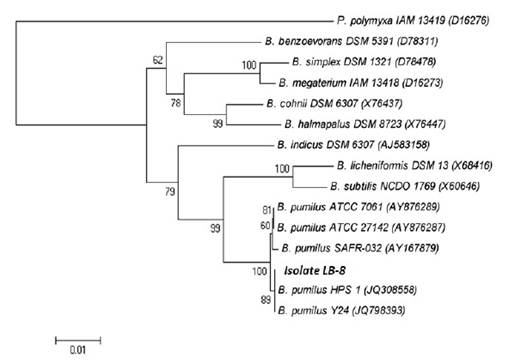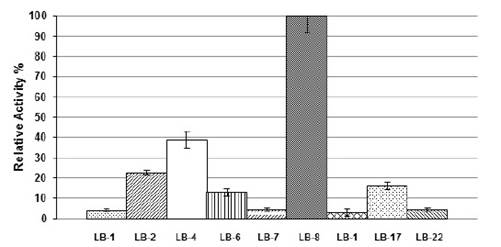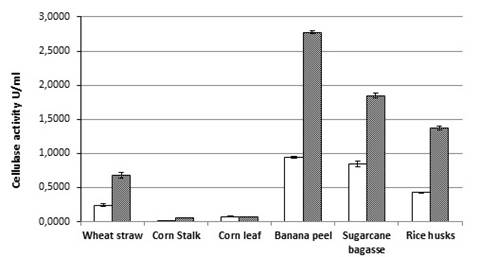INTRODUCTION
Cellulose is an unbranched glucose polymer, composed of anhydro-D-glucose units linked by 1,4-β-D-glucoside bonds, which can be hydrolyzed by cellulolytic enzymes produced by both bacteria and fungi 1. Cellulose can be considered as the most abundant and biologically renewable resource for bioconversion processes. Thus, the progress in biotechnology of cellulases and related enzymes is a promising way for obtaining sugars from lignocellulosic materials. The possibility of enzymatically converting the cellulose present in forest products and agro-industrial waste into useful products like bioethanol is emerging as an alternative to fossil fuels. The necessity of cost reduction in the bioethanol production industry led to renewed interest in these types of enzymes 2,4
The microbial biodiversity of extreme environments represents a promising source for more stable, highly active, and specific enzymes. Lakes and lagoons distributed in the Andes, are subjected to extreme temperature variations, high UV radiation levels as well as a wide range of pH values and metal concentrations. In order to survive microorganisms isolated from these environments have developed strong metabolic systems for adaptation. Laguna Blanca is located in Bolivian highlands at 4,300 m above sea level, in Potosí-Bolivia, into a xeric volcanic landscape of the High Andean Ecoregion, its coloration is quite white caused by the high content of salt and minerals in its waters 5.
Enzymes produced by extremophiles are currently under study due to their properties and potential applications. Bacterial cellulases have been reported over the past decades; nonetheless, new strains are still under studies since new microorganisms represent a promising source of new enzymes which may be more stable under industrial process conditions 6,7. The present study evaluates the bacterial biodiversity of Laguna Blanca, Potosi-Bolivia, for cellulase production using low price substrates.
EXPERIMENTAL
Chemicals
Agro-industrial waste was provided by local feed plants: wheat straw, corn stalk, corn leaves, and rice husks. Meanwhile, banana peel and sugarcane waste where from local markets. All other chemicals were purchased either from Merck or Sigma. All other chemicals used in the present study were of analytical grade.
Isolation and selection of cellulase-producing microorganisms
Water samples were collected from Laguna Blanca shoreline in 100 ml sterile flasks from the surface water body (22º46’ S, 67º47’ W), Potosí-Bolivia, and stored at 4 ºC before processing. The samples were enriched on growth liquid medium for chemotrophic microorganisms (QM) containing (%, w/v): [Yeast extract - 2, peptone - 1, MgCl2.6H2O - 0.875, MgSO4.7H2O - 0.6, KCl - 0.125, C6H5Na3O7 - 0.1, CaCl2.2H2O - 0.025, NaBr - 0,0125%, NaHCO3 - 0,005, NaCl 0 to 15] and for heterotrophic (HM) microorganisms containing (%, w/v): [ Yeast extract - 1, peptone - 0.5, glucose - 0.1, MgSO4.7H2O - 0.025, KCl - 0.05, CaCl2.2H2O - 0.009, NaBr - 0.006, NaCl - 0 to 15] the pH was adjusted to 7 using a 2M NaOH solution. Cellulase-producing microorganisms were selected in liquid medium (QM/HM) supplemented with filter paper, 1 % (w/v), as sole carbon source in a rotary incubator shaker (Innova 4430, New Brunswick Scientific) at 200 rpm orbital agitation speed and 30 ºC. Cell growth was monitored by measuring the optical density in a spectrophotometer (UV-Vis 1601, Shimadzu) at 600 nm, and stock cultures were maintained on isolation medium at 4 ºC and as glycerol stock at -20 ºC.
Effect of NaCl concentration and pH on microorganism growth
Solid culture medium (QM/HM), with added agar 1,5% (w/v) and pH 7, was prepared at different NaCl % (w/v) concentrations: 0, 5, 10 and 15 and inoculated with the best cellulolytic enzyme producer. The pH effect on the microorganism growth was evaluated with the best NaCl % (w/v) concentration previously determined, at pH values of 6, 7, 7.5, 8 and 9. The cultures were grown at 30 ºC for 12 hours and positive or negative bacterial growth was observed in solid medium.
Cellulase production using forest products and agro-industrial waste
Enzyme production was studied in liquid culture medium (QM/HM) supplemented with filter paper 1% (w/v) as sole carbon source and incubated at 30 ºC and 200 rpm orbital agitation speed for 48 hours. At 12 hours intervals, aliquots were withdrawn and centrifuged at 7.155 x g for 10 min. The cell free supernatant was analyzed for cellulolytic activity.
Those strains selected as best cellulase producers were cultivated in liquid culture medium (QM/HM) supplemented with 1% (w/v) organic waste individually: forest products like pine wood and different types of paper (newspaper, printing paper, office paper and filter paper) as well as agro-industrial waste like wheat straw, corn stalk, corn leaves, banana peel, sugarcane, and rice husks as carbon source. The cultures were grown at 30 ºC, 200 rpm for 15 hours, samples were taken each 3 hours and the cell-free supernatant after centrifugation was analyzed for cellulase enzyme activity, measurements were performed in duplicate. All the substrates used were rinsed twice with distilled water, dried at 50°C, stored at -20°C until use and sterilized with the medium.
The optimum pH of the enzyme crude extract of the selected strain was measured at 37°C by using buffer solutions of different pH values. The following buffers (50mM) were used: potassium phosphate (pH 6.0-8.0), Tris-HCl (pH 8.0-9.0) and glycine/NaOH (pH 9.0-12). In order to determine the optimum temperature for the enzyme extract, cellulase activity was assayed at 20, 30, 37, 40, 50 and 60 ºC.
Statistical analysis
Mann-Whitney U Test (non-parametric data) was used for statistical analyses for all the organic waste substrates tested. A Wilcoxon Signed Ranks Test was used to evaluate the groups of organic waste in this study 8.
Microorganisms identification
In order to identify the isolated species, deoxyribonucleic acid (DNA) extraction, 16S rDNA gene amplification, and sequencing of the PCR products were carried out at Bio Basic Inc. (Canada). The analysis of the DNA sequences was performed with the BLAST server in the National Center for Biotechnology Information (http://www.ncbi.nlm.nih.gov) using the BLAST algorithm and the BLASTN software for the comparison of a nucleotide query sequence against a nucleotide sequence database. 16S rDNA sequence analysis was performed with the MEGA X software package using the neighbor-joining method 9. For the phylogenetic trees, only sequences from the type strains whose names have been validly published were taken into account.
Analytical methods
Cellulase assay
The cellulose enzyme activity was determined by measuring the release of reducing sugars from filter paper (1% w/v) by dinitro salicylic acid (DNS) method. A 100 μl of the enzyme extract was mixed with 200 μl of DNS and incubated in a boiling water bath for 10 min, the reaction was stopped in a cold water bath and then the absorbance at 540 nm was measured on the spectrophotometer. A blank with 100 µl of distilled water instead of the enzyme extract was used in all the different tests 10. One unit of cellulase activity was defined as amount of enzyme required to release 1µmol of glucose from filter paper in 1 minute under standard conditions.
Reducing sugars determination
Estimation of total reducing sugars in the enzymatic hydrolysate of biomass was quantified by DNS method 10.
RESULTS AND DISCUSSION
Cellulase-producing microorganism selection
A total of 71 bacterial strains were isolated from Laguna Blanca liquid samples and grown in liquid medium supplemented with filter paper as sole carbon source. From 32 strains which gave positive results for cellulase production, 9 reported higher cellulase activity in liquid media. The strains coded as LB-1, LB-2, LB-4, LB-6, LB-7, LB-8, LB-13, LB-17 y LB-22 were selected for further studies. Successful screening of novel cellulase-producing strains represents a strategy for multifunctional cellulases production with broader substrate utilization as well as wider temperatures and pH activity range conditions 11.
Effect of NaCl concentration and pH on microorganism growth
The 9 strains selected were grown at different NaCl concentrations ranging for 0 to 15% (w/v) from those, 7 strains: LB-4, LB-6, LB-7, LB-8, LB-13, LB-17 and LB-22 were identified as halophilic and 2 strains: LB-1 and LB-2 as halotolerant. Microorganisms that grew between 3 and 15% (w/v) NaCl are considered halophiles and those that grow well without NaCl and are able to grow in the presence of NaCl are defined as halotolerant. Enzymes produced by these microorganisms have proved to present remarkable properties of commercial interest due to its stability at different salt concentrations and pH values 12. Screening studies in saline habitats have reported numerous microorganisms as source of extremophilic enzymes with promising applications in biotechnological processes mainly because they are subjected to different environmental stresses simultaneously 13.
Cell growth classification according to different pH values was carried out considering alkaliphilic microorganisms those that grow optimally in pH values greater than 9, meanwhile neutrophiles grow optimally in pH values between 6 and 9. Alkalotolerants are those microorganisms that grow optimally near neutral pH but also tolerate pH values greater than 9 [13]. Five strains: LB-2, LB-4, LB-6, LB-7 and LB-8 are neutrophiles meanwhile 4 strains: LB-1, LB-13, LB-17 and LB-22 are alkalotolerants. Extracellular salt-tolerant enzymes of moderately halophilic bacteria and alkaliphilic/alkalotolerant enzymes from akaliphilic bacterial strains offer broad application in biotechnological processes in food, laundry detergent, leather, and paper/pulp industries. Thus, a considerable effort has been dedicated to the study of such enzymes due to its remarkable properties 14,16.
The 9 selected strains were cultivated in liquid media supplemented with filter paper, 1% (w/v), as sole carbon source. Higher enzyme activity values were registered at 12 hours and strains LB-4 and LB-8 were selected for further studies (Fig. 1).
Cellulase production using organic waste: forest products and agro-industrial waste
The 2 strains selected as best cellulase producers (LB-4 and LB-8) were cultivated in liquid culture media supplemented with 1% (w/v) organic waste: forest products and agro-industrial waste as carbon source. However, a Mann Whitney U Test indicated that the difference between cellulose activity of the selected strains onorganic waste tested was non-significant (U=48, p=0.206). After 9 hours cultivation in forest products, strain LB-4 showed highest enzyme activity values using printing paper, 0.071 (U/ml), and pine wood, 0.114 (U/ml), meanwhile for strain LB-8 the highest values were registered when using newspaper, 0.150 (U/ml), and pine wood, 0.148 (U/ml), (Fig. 2). Paper recycling represents a subsection of paper industry oriented towards re-use and sustainability. The application of cellulases for paper recycling has proved to improve defibering and ink particle detachment 17,18). Strains LB-4 and LB-8 were able to growth using different types of papers as well as pine wood thus they can be applied in industrial paper processes.

Figure 2 Cellulase activity (U/ml) for strains (  ) LB-4 and (
) LB-4 and (  ) LB-8 using 1% (w/v) forest products as carbon source. Error bars represent the mean ± 2SD of duplicate samples.
) LB-8 using 1% (w/v) forest products as carbon source. Error bars represent the mean ± 2SD of duplicate samples.
In the case of agro-industrial waste, the highest enzyme activity for LB-4 and LB-8 was detected using banana peel, 0.944 (U/ml) and 2.774 (U/ml), respectively. In the same way, using sugarcane bagasse presented activity values of 1.849 and 2.774 (U/ml) for both LB-4 and LB-8 (Fig. 3). Cellulose is a linear polysaccharide polymer that greatly differs from one source to another in structure. Therefore, the hydrolysis of this material depends on the type of residue a Wilcoxon Signed-Ranks Test indicated that there is a significant difference in the enzyme activity by the two strains (Z =2.55, p = 0.011) when agro-industrial organic waste was tested for cellulases. Strain LB-8 registered higher enzyme activity values when compared to strain LB-4, 2.774 (U/ml). Therefore, strain LB-8 was selected for phylogenetic analysis. Cellulase production using agro-industrial waste is an economical option, since harvesting and processing agricultural feedstock produce an enormous quantity of solid lignocellulosic residue that can be considered one of the major environmental pollutants due to their unchecked accumulation. Microorganisms degrade lignocellulosic material due to their highly efficient enzymatic system, thus, several studies are directed towards the production of hydrolytic enzymes using low-cost substrates that can be applied in biotechnology and biorefinery approaches for fuel generation, chemicals production as well as energy sources 19,21
Phylogenetic analysis
The isolate was identified on basis of 16S rRNA sequencing. A comparison of the DNA sequence with sequences in the National Center for Biotechnology Information (NCBI) database with BLAST software showed 99.99 % sequence identity with the published 16S rRNA sequences of Bacillus pumilus. The phylogenetic tree showed that strain LB-8 formed evolutionary lineage with members of the Bacillaceae family associated with members of the diverse Bacillus spectrum (Fig. 4). Several bacterial strains of Bacillus, Pseudomonas, Clostridium and Cellumonas have shown cellulolytic activity under various culture conditions 22,23. Some strains belonging to this species have been reported for its ability of cellulase production, nevertheless, enzyme characterization reveals that this enzyme was optimally active at pH 6 and temperature 60 ºC meanwhile the enzyme in this study is optimally active at pH 9 and temperature 50 ºC 24).

Figure43 Phylogenetic tree of members of the genus Bacillus, based on 16S rRNA gene sequences. The tree was constructed using the neighbor-joining method and the Jukes-Cantor distance matrix. Paenibacillus polymyxa IAM 13419 was used as the outgroup. Accession numbers are given in parentheses. Bar, genetic distance of 0.01.
CONCLUSION
Enzyme production can be improved in order to generate a suitable technology for economical processes. Different strategies have been implemented based in low-cost residues for cellulase production identifying major parameters affecting enzyme production 25,27. The nine strains tested positive for cellulase production presented both halophilic and alkalotolerant properties. Strain LB-8 was able to growth at pH values ranging from 6 to 9; meanwhile positive cellular growth was observed at NaCl concentration up to 15 % (w/v). The use of agro-industrial waste like banana peel, sugarcane bagasse, rice husks, and wheat straw by strains LB-4 and LB-8 revealed better values of enzyme production from those values determined using forest products. This study presents several options of low-cost substrate to support cellulase production by these strains.












 uBio
uBio 



